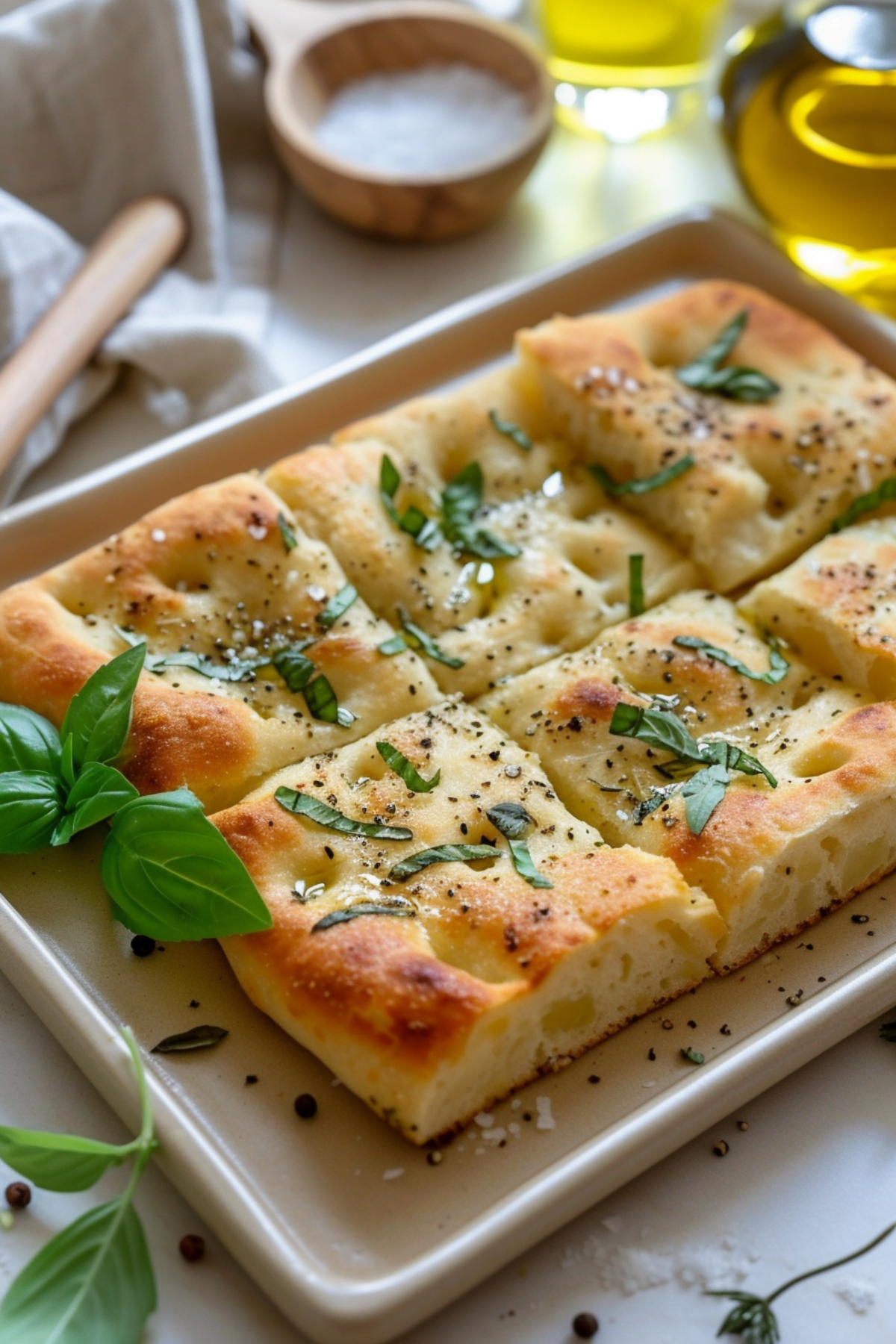Ligurian Basil and Potato Focaccia: A Taste of Italy’s Riviera
Embark on a culinary journey to the Italian Riviera with our Ligurian Basil and Potato Focaccia. This recipe is a celebration of simple yet exquisite flavors, where the humble potato and aromatic basil come together on a canvas of soft, golden focaccia. Whether you’re a seasoned baker or new to the art of Italian bread, this dish will transport your senses to the sun-drenched coast of Liguria.
Imagine the salty sea breeze and the rustic charm of Ligurian villages as you indulge in this focaccia, a perfect side to any meal or a delicious snack on its own. With each bite, you’ll savor the earthiness of the potatoes, the freshness of the basil, and the rich, fruity notes of extra-virgin olive oil. Let’s dive into the making of this traditional Italian bread that promises a slice of Mediterranean heaven.
Our Ligurian Basil and Potato Focaccia is not just a recipe; it’s a story of tradition, a homage to Italian baking, and a testament to the flavors that define Mediterranean cuisine. Prepare your kitchen for an aromatic adventure, and let’s begin!
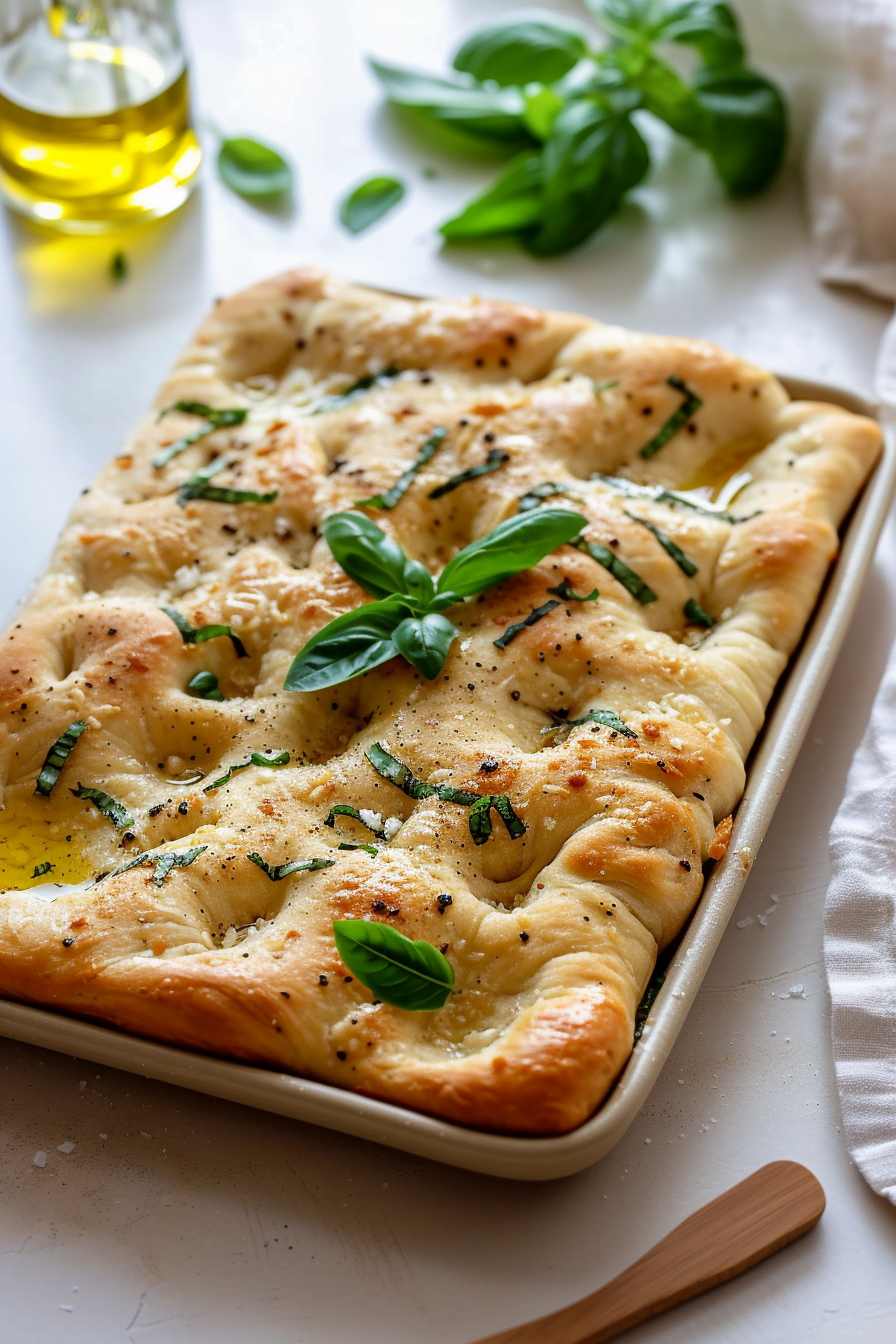
From the Heart of Liguria: The Origins of Basil and Potato Focaccia
The Ligurian Basil and Potato Focaccia is a delightful variation of the classic Italian focaccia, which has been a staple in the region of Liguria for centuries. The addition of thinly sliced potatoes and fresh basil leaves to the traditional focaccia dough creates a harmonious blend of flavors that is both comforting and invigorating.
Liguria, known for its stunning coastline and picturesque landscapes, is also celebrated for its culinary contributions, particularly its use of fresh herbs and vegetables. Basil, one of the most cherished herbs in the region, is the star ingredient in the world-famous pesto Genovese. It’s no surprise that this fragrant herb has found its way into the local bread-making tradition, infusing focaccia with its distinctive, peppery sweetness.
The inspiration for this recipe comes from the Ligurian practice of utilizing the region’s bountiful produce. The potatoes, grown in the terraced hillsides, offer a subtle earthiness and a tender bite that complements the focaccia’s crisp exterior and fluffy interior. This bread is a testament to the resourcefulness of Ligurian cuisine, which turns simple ingredients into extraordinary dishes.
Our Ligurian Basil and Potato Focaccia recipe captures the essence of this coastal region. It’s a celebration of the Ligurian spirit, where the love for food and the joy of sharing come together in every bite. This focaccia is not just bread; it’s a piece of Liguria’s soul, served warm and sprinkled with sea salt crystals that glisten like the Mediterranean sun.
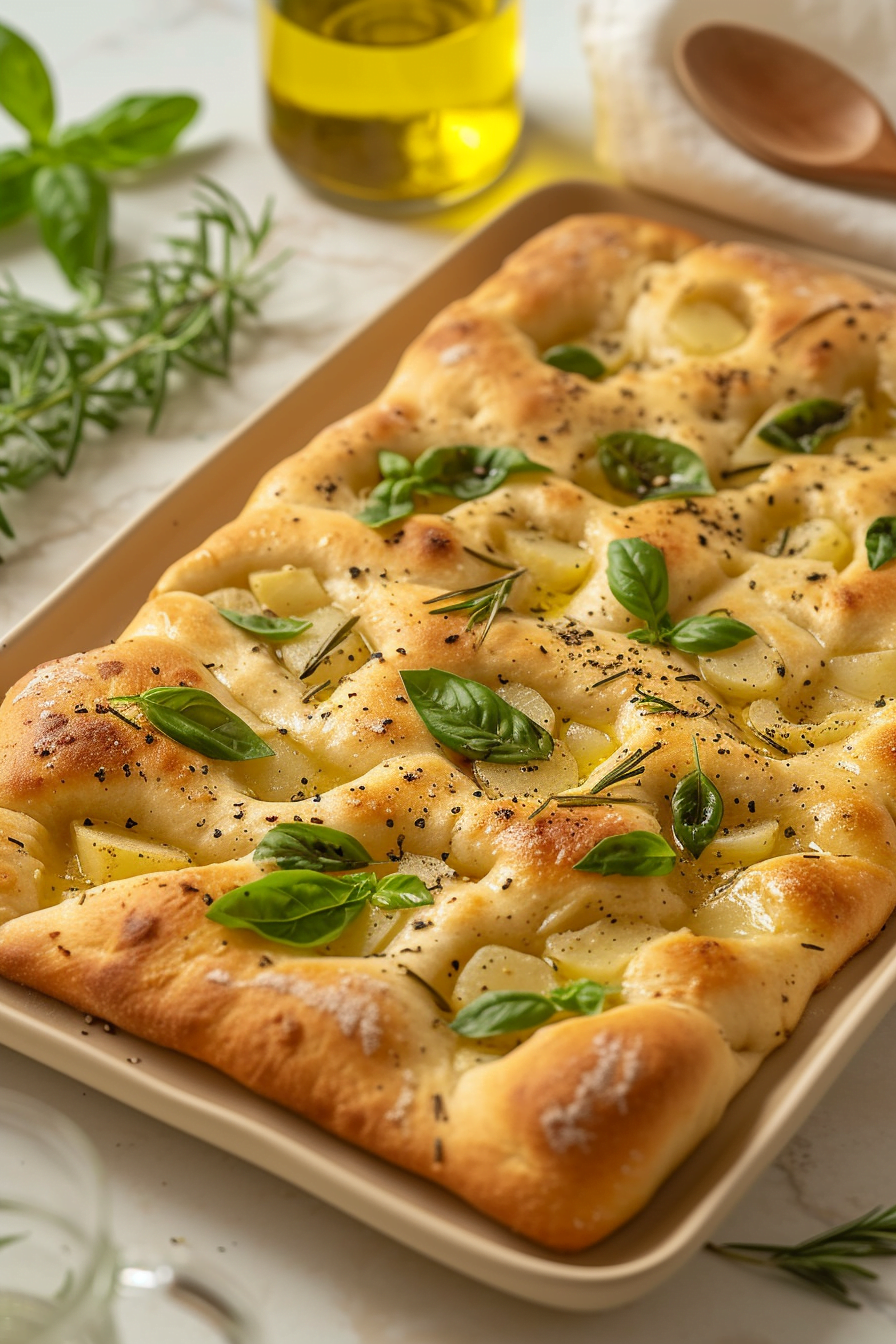
Mastering the Method: Tips for Perfect Focaccia
To achieve the perfect Ligurian Basil and Potato Focaccia, one must embrace the nuances of Italian bread-making. The process begins with the **activation of the yeast**, which is crucial for a light and airy dough. Ensure your water is warm, not hot, to avoid killing the yeast. Once it’s foamy, you’re on the right track.
When **kneading the dough**, patience and attention to texture are key. Aim for a smooth, elastic consistency, adding flour as needed to prevent sticking. This step is therapeutic, as you pour your passion into the dough, readying it for its transformation in the oven.
The **rising process** is where the magic happens. A warm, draft-free environment will encourage the dough to double in size, creating the pockets of air that define focaccia’s characteristic crumb. During the second rise, after you’ve stretched the dough onto the baking sheet, take the time to create those iconic dimples with your fingertips. This not only adds to the bread’s rustic charm but also helps to anchor the toppings.
Speaking of toppings, the arrangement of the **potato slices and basil** is both an art and a science. Overlap the potatoes just enough to create a beautiful pattern without overcrowding, which could result in a soggy texture. The basil leaves, torn by hand, should be nestled among the potatoes, ready to release their aroma as they bake.
As the focaccia bakes, watch for the **golden-brown color** to develop. This is the sign of a well-baked crust, indicative of a crunchy exterior that gives way to a pillowy softness inside. Once out of the oven, resist the urge to cut into it immediately. Letting it cool on a wire rack will preserve the crust’s integrity, ensuring that each slice is as perfect as the last.
Remember, the beauty of this Ligurian Basil and Potato Focaccia lies in its simplicity and the quality of its ingredients. Using a high-quality Ligurian olive oil can make all the difference, adding a depth of flavor that honors the bread’s regional roots.
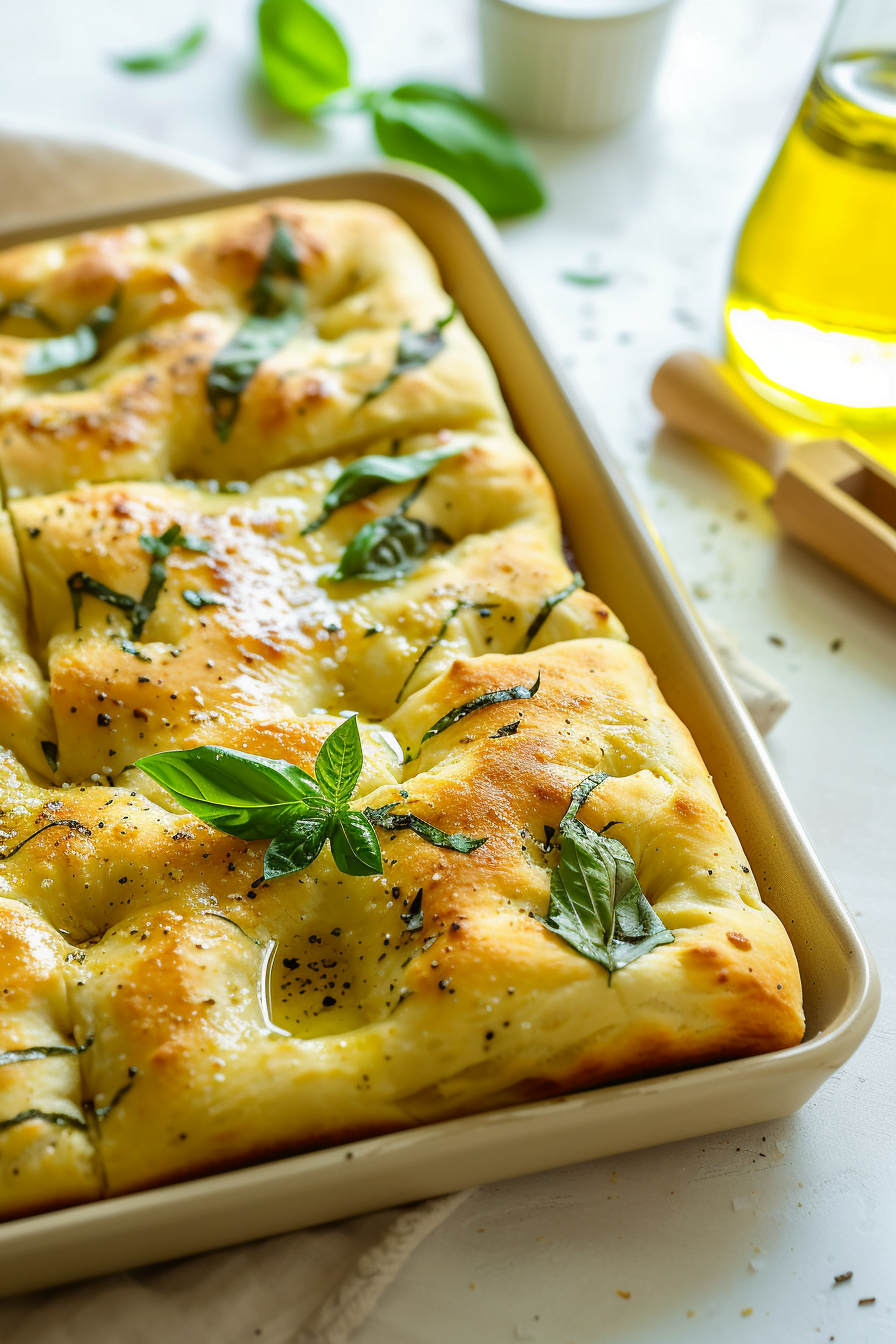
Variations to Savor
While the classic combination of basil and potato is hard to beat, there are several variations you can explore to tailor this focaccia to your taste:
Cherry Tomato and Olives
Add a burst of color and flavor by topping your focaccia with halved cherry tomatoes and pitted Kalamata olives before baking. The sweetness of the tomatoes and the briny contrast of the olives create a Mediterranean flavor profile that’s both vibrant and satisfying.
Caramelized Onion and Thyme
For a sweeter take, try caramelizing onions until they’re golden and tender, then sprinkle them over the dough along with fresh thyme leaves. The onions’ natural sugars will complement the earthy thyme, resulting in a focaccia that’s rich in umami.
Zucchini and Goat Cheese
Thinly slice zucchini and arrange it on the dough, then dot with crumbled goat cheese for a focaccia that’s as elegant as it is delicious. The zucchini’s mild flavor pairs beautifully with the tangy goat cheese, making for a sophisticated twist on the classic recipe.
Substitutions for Every Kitchen
Whether due to dietary restrictions or a desire to experiment, substitutions can help you adapt the Ligurian Basil and Potato Focaccia to your needs:
Gluten-Free Flour
For those avoiding gluten, a high-quality gluten-free all-purpose flour blend can be used in place of traditional flour. Look for a blend that includes xanthan gum, which will help mimic the texture and elasticity of gluten.
Sweet Potato
If you’re looking for a sweeter, nutrient-rich alternative to white potatoes, sweet potatoes are an excellent choice. Their vibrant color and natural sweetness will add a unique twist to the focaccia, while still maintaining the heartiness of the original recipe.
Dairy-Free Cheese
For a dairy-free version, sprinkle your focaccia with your favorite dairy-free cheese alternative before baking. Many plant-based cheeses melt beautifully and can add a creamy dimension to the bread without the use of dairy.
Frequently Asked Questions
Can I make the dough ahead of time?
Yes, you can prepare the dough and let it rise slowly in the refrigerator overnight. This can enhance the flavor and make the baking process more flexible.
How do I store leftover focaccia?
Wrap the cooled focaccia tightly in plastic wrap or store it in an airtight container. It will keep at room temperature for up to 2 days or in the refrigerator for up to a week.
Can I freeze this focaccia?
Absolutely. Wrap the baked and cooled focaccia in foil and place it in a freezer bag. It can be frozen for up to 3 months. Thaw at room temperature and reheat in the oven for best results.
What’s the best way to reheat focaccia?
Reheat slices of focaccia in a preheated 350°F (175°C) oven for about 5 minutes or until warmed through. This will help maintain its crispy crust and soft interior.
Can I use dried basil instead of fresh?
While fresh basil is preferred for its flavor, in a pinch, you can use dried basil. Remember to use a third of the amount, as dried herbs are more concentrated than fresh.
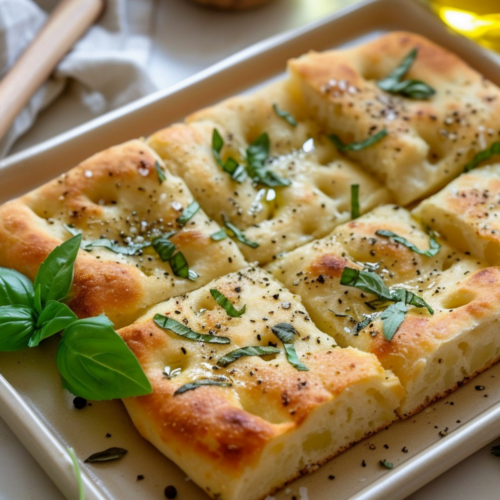
Ligurian Basil and Potato Focaccia
Equipment
- Mixing bowls
- Measuring cups and spoons
- Baking sheet
- Cloth for covering dough
- Pot for boiling potatoes
- Wire rack
Ingredients
Dough
- 3 cups all-purpose flour 360g
- 1 cup warm water 240ml
- 2 tsp sugar 8g
- 1 packet active dry yeast 7g or 2 1/4 teaspoons
- 1/4 cup extra-virgin olive oil 60ml, plus more for drizzling
- 2 tsp sea salt 10g, plus more for topping
Toppings
- 1 large potato 200g, thinly sliced
- 1/2 cup fresh basil leaves 20g, torn
- 2 tbsp fresh rosemary leaves 6g, chopped
- Freshly ground black pepper to taste
Instructions
- Prepare the Yeast Mixture: In a small bowl, dissolve sugar in warm water. Sprinkle the yeast over the water and let it sit for 5 minutes, or until foamy.
- Make the Dough: In a large mixing bowl, combine flour and salt. Make a well in the center and pour in the yeast mixture and 2 tablespoons of olive oil. Mix until a sticky dough forms.
- Knead the Dough: Turn dough out onto a floured surface and knead for about 10 minutes, until smooth and elastic. Add more flour if the dough is too sticky.
- First Rise: Place the dough in a clean, oiled bowl and cover with a damp cloth. Let it rise in a warm place for 1 hour, or until doubled in size.
- Prepare Potatoes: While the dough is rising, bring a pot of salted water to a boil. Add the potato slices and cook for 2 minutes. Drain and set aside to cool.
- Shape the Focaccia: After the first rise, punch down the dough and stretch it onto an oiled baking sheet, creating a rough rectangle. Cover and let it rise for another 30 minutes.
- Preheat Oven: Preheat the oven to 425°F (220°C).
- Add Toppings: Gently press the potato slices, basil, and rosemary into the surface of the dough. Drizzle with olive oil and sprinkle with sea salt and black pepper.
- Bake: Place the focaccia in the oven and bake for 20-25 minutes, or until golden brown.
- Cool and Serve: Remove from the oven, let it cool slightly on a wire rack, then cut into squares and serve.
Notes

